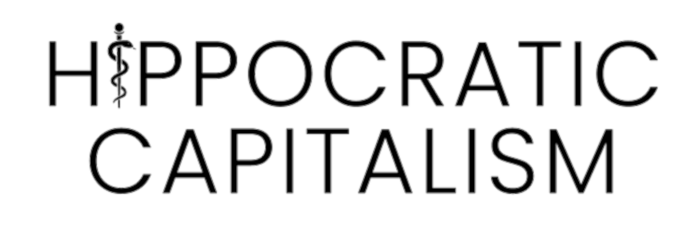Must the Sky Be the Limit on Drug Prices?

A new world record for drug prices was set last week. Orchard Therapeutics announced that they will charge $4,250,000 per patient for Lenmeldy, a gene therapy for metachromatic leukodystrophy. Which raises a few questions:
- How did the company come up with this price?
- Is this therapy really worth over 4 million dollars?
- What does this mean for drug costs more broadly, and by extension healthcare costs?
And finally, the Hippocratic Capitalism question:
- Is this "free market" pricing?
First, though, some background on the disease. Metachromatic leukodystrophy is a rare (roughly 1/50K-100K births) and horrible neurologic disease. The most severe forms show symptoms starting before age 2; other forms show up a few years later. Until now there has been no effective treatment. Affected children gradually lose neurologic function, becoming wheelchair-bound, then losing the ability to swallow and breathe on their own, and ultimately dying 6-20 years later. It’s obviously devastating to patients and their families. Even worse: Because this is a genetic disease that’s not apparent at birth, some families end up with multiple affected children.
Orchard’s treatment involves a bone marrow transplant using the patient’s own stem cells, the DNA of which is modified using a lentivirus to insert a working copy of the affected gene. This approach has previously been used with good success for a handful of other genetic diseases. In clinical trials, Lenmeldy appeared to completely stop disease progression. And so far, the treatment appears to be durable (though the first patient was only treated about a decade ago, so we don’t have long-term followup data). In sum: a miracle drug.
So how did Orchard come up with the eye-popping price?
First of all, let’s consider the costs from Orchard’s perspective. Because this is a rare disease, the company says that it only expects 14 patients per year in the U.S. to end up being treated. That number could go up several-fold with widespread genetic screening, since eligibility is limited to patients discovered prior to the onset of symptoms. But to start with, 14 times $4.5M equals $63M/year. Add to that the roughly $15M/year that they're making in Europe where the treatment has been available for a couple of years (and the price is closer to $2M). What would that mean for Orchard’s return on investment? The most relevant comparison number might be $400M, which is the price paid last year for Orchard by the Japanese pharma company Kiowa Kirin. $78M/year minus operational costs isn’t actually a stellar return on $400M. So from a cost perspective, the price looks reasonable, right?
But in a market economy, prices aren’t directly based on production costs. They’re based on supply and demand and willingness to pay. With a disease like metachromatic leukodystrophy, families’ willingness to pay is more or less infinite. However, almost no family is in a position to pay $4.5M out of pocket, even when you take into account friends-and-family, community bake sales, GoFundMe, etc. This is an amount that will only be covered by some form of insurance.
So how would an insurance company think about the price? Metachromatic leukodystrophy is an expensive disease to treat, with estimated lifetime costs of about $1M per patient. Unfortunately, the cost of bone marrow transplant and associated care is also estimated at about $1M per patient. So Orchard would have to give the drug away for free in order for it to break-even from an insurance perspective. Which isn’t going to happen.
Enter cost-effectiveness analysis (CEA). In many countries such as the UK, formal CEA is used to determine price caps on new drugs. In the US, it plays a more complicated role, but private insurers do use it in their coverage decisions. ICER, the nonprofit Institute for Clinical and Economic Review, has published a CEA of Lenmeldy in which they estimate that if it were priced at $2.8M/treatment and used only for the most severe forms of the disease, it would result in a cost of close to $500K per quality-adjusted life year gained. Use for the later-onset forms would be a bit more cost effective, coming out to about $200K per QALY. (Why is treating the less-severe forms more cost-effective? Because they kill patients more slowly, meaning more years of medical and care-giving expenses in the absence of treatment.) But again, this is assuming a price of $2.8M, which is a lot less that $4.25M. Based on the higher price, we should figure something closer to $750K/QALY for the early-onset form, and $300K/QALY for the later-onset form. Is that too much to pay?
My answer is yes. Back in the 1990s when I was doing CEA research on blood safety (specifically, the use of more sensitive and more expensive tests to screen donor blood for viral hepatitis and HIV), our rule of thumb was that $50K/QALY was “reasonable.” Adjusted for inflation, that would be maybe $100K/QALY today. But it’s admittedly an arbitrary number. First of all, humans don’t intuitively think in terms of QALYs, even though the concept is pretty simple. You just take the number of years of life saved by the therapy, then adjust that number to reflect what percentage of “full” life that represents. If Lenmeldy results in a full normal life, versus a short miserable one, then that’s a lot of QALYs for the average patient.
My larger concern is that this way of thinking about price doesn’t scale well. In the U.S. we have many people who have serious unmet needs. For sake of argument, imagine a 10 year old impoverished kid in south Chicago who’s just been recruited into a gang. That kid has a high risk of death before age 20, and an even higher risk of incarceration, which would dramatically lower both life expectancy and total quality of life. I bet that with less than $1 million per child, you could design a program to pull kids their families out of bad environments, provide excellent school situations, and set them on a track to success. And while I haven’t done the CEA calculations, I’m pretty the numbers would end up looking more favorable than Lenmeldy’s. And that’s just one idea of the top of my head. What else could you do with unlimited resources? How about providing therapists to all depressed teenagers? You can’t argue there’s not a huge need for that. Or how about affordable, convenient childcare for low-income parents who are struggling to hold down stable jobs to care for their families? Admittedly this last example isn’t healthcare, but nothing about the QALY concept says that it has to be restricted to medical activities. The bottom line is that CEA and QALY’s represent a utilitarian approach, and if that’s how we’re going to allocate public resources, then we need to look at the full spectrum of ways society could spend that money. I’m all in favor of society spending a lot of money to cure kids with fatal genetic diseases. But it also feels like there should be some sort of reality check on just how much gets spent. If insurance companies agree to pay $4.25M per dose of Lenmeldy, then what’s to stop Orchard or another company from charging $10M for the next cure that comes along? Or $20M? Or $100M? Or $1B? I realize I’m sounding crazy here, but seriously, where’s the natural limit to drug pricing?
Now let’s apply the Hippocratic Capitalism question: Is this "free market" pricing? No. Orchard’s price is the equivalent of a fire department showing up at a burning house with a child trapped inside, and then demanding $4.25M to go in and save the child. The technical term for this is extortion. The availability of gene therapy puts parents of affected kids in an impossible position to do anything other than lobby like crazy for insurance coverage at any price. And Orchard and their parent company know that.
For a market to function properly in the Adam Smith sense (i.e. to be a “free” market), it has to be free of monopoly effects. Now, I realise that there’s a reason why we grant monopolies to drug companies in the form of patents, namely to provide incentives for innovation. And that approach works ok much of the time, when the existence of socially acceptable substitutes constrains companies’ ability to price a product. But that’s just not the case with a disease like metachromatic leukodystrophy.
Are there other market-based approaches that would work here? Absolutely. One is to use prizes to provide incentive for innovation. (See also my previous newsletter, Patents vs Prizes.) In this scenario, the core intellectual property for a therapy like Lenmeldy could then be retained in the public domain, so that multiple pharmaceutical companies (not to mention academic medical centres) could develop and provide competing products. Prices would then be determined by the market rather than by extortion.
A related option, which would probably require a single insurance payer, would be to set the price of therapy in advance. (To apply this in the US context, you could imagine carving out a national insurance program that only covered fatal genetic diseases of childhood.) The insurer would determine up front what prices it would pay for different treatment outcomes. Given the huge burden of metachromatic leukodystrophy, the reward for a cure would likely be pretty high, maybe even a couple million $. But the key is that the price would be capped, and biotech companies and their investors would make their decisions based on that capped number. Would this mean that fewer companies would go after moonshot treatments? Maybe. But if that meant that R&D money would instead be spent on innovations that could relieve more aggregate suffering and produce more net QALYs, then from a utilitarian perspective that would be a good thing.
